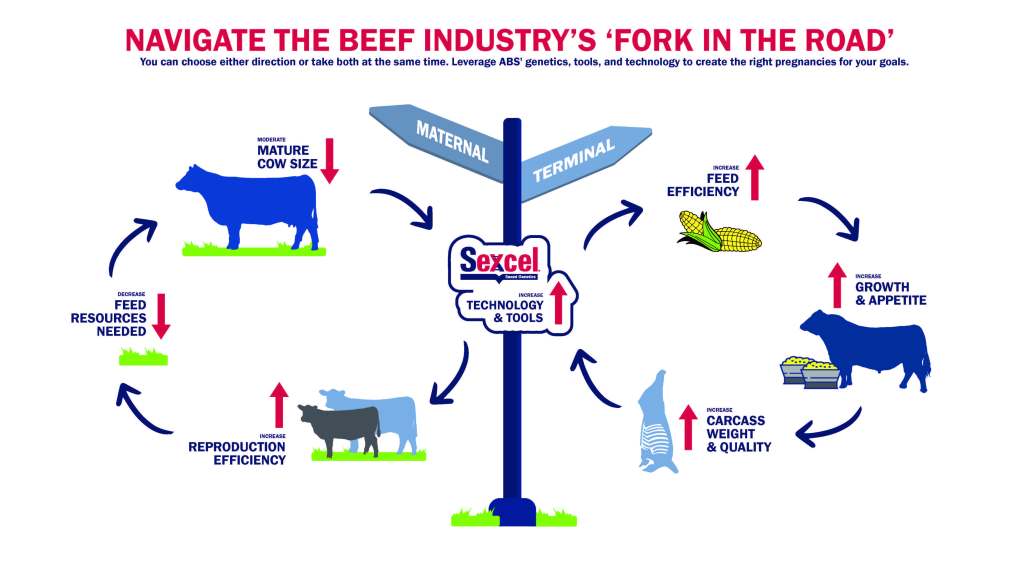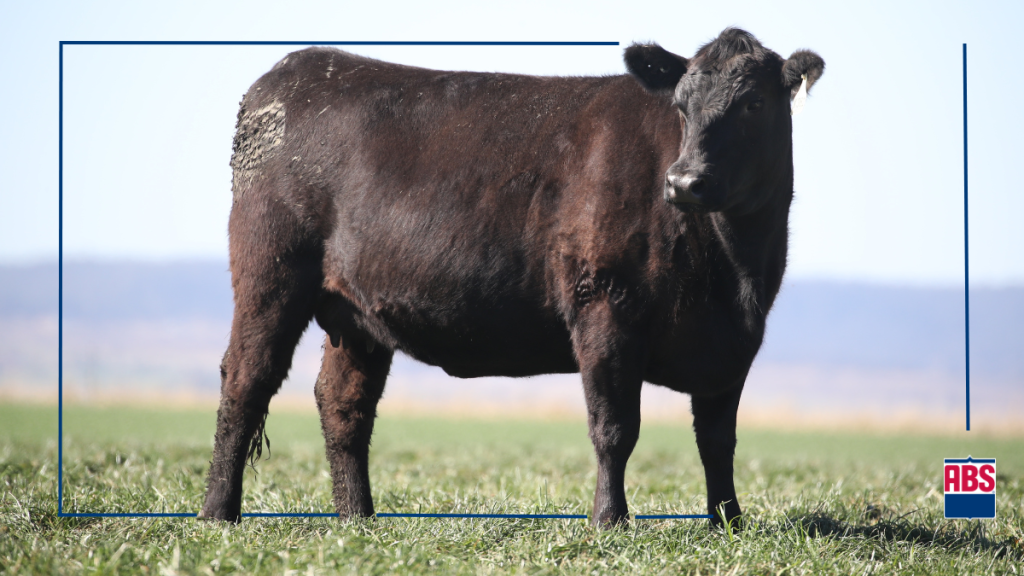Publish Date: 8/29/23
There’s a fork in the road for beef producers, and those who embrace it will reap the rewards. The fork represents the vast difference between genetics that maximize feedlot and carcass performance versus genetics that optimize maternal efficiency and profitability at the farm or ranch level. Some producers have already reached this fork in the road, and indecisiveness about which path to take has likely led to sacrifices. The decision to breed “down the middle,” or not embrace diverging paths has almost certainly resulted in a sacrifice in either maternal or terminal traits.
Historically, a bull had to do everything well, from pasture to plate. Today, with tools like fixed-time AI and Sexcel, we can laser-focus our breeding decisions to create maternally efficient replacement females and exceptionally profitable feeder cattle, without sacrifice. Whether you are concerned about sustainability, efficiency, or making the most of your resources at hand, embracing the “Fork in the Road” may be your solution to maximizing profitability. The most exciting part is you do not have to compromise any longer.
With ABS, you have the tools and genetic offerings to take either path or segment your herd to achieve both.
EPDs and genetic selection tools such as genomics and economic indexes have accelerated us to a point where we can create cattle that generate exceptional profit in the feedlot and on the rail. But is that type animal truly practical at a farm or ranch level? Likely not in all cases.

Handpicking the Right Genetics for a Cow Herd
We routinely see cattle that push boundaries for carcass and live weight, a capability that is highly desirable in the cattle feeding industry. Those same cattle tend to have exceptionally high appetites and growth rates which leads to fewer days on feed and improved efficiency. All things favored in the feedlot.
On the other hand, imagine these same traits manifested as large mature sizes, high feed intake, and increased maintenance requirements in a cow herd. Over recent decades, many ranchers have steadily watched their once-moderate statured cows trend toward a much larger, higher input type of female. While it clearly takes more land and feed resources to maintain these cows, the industry trends for weaning weight indicate that their output has not offset that increase.
Still, we can’t ignore the demands of the cattle feeder, the packer, or the consumer in our quest for efficiency. Expectations at each of these levels have never been higher.
Expectations of the Feeders, Packers, and Consumers
- High performing, healthy cattle
- Feed efficiency
- High quality carcasses
- Exceptional eating experience
The feeder expects fast-growing, healthy cattle that convert feed to pounds of carcass weight efficiently. The packer expects as much high-quality carcass weight as they can get for every hook space in their plants. The consumer expects an exceptional eating experience that they can “feel good” about consuming.
Choosing Genetics for the Beef Supply Chain
We are operating in an industry with a rapidly improving ability to “connect the dots” from ranch to grocery store. Our consumer wants to know the when, where, and how their food was produced. The beef industry as a whole has made tremendous strides toward a better-quality product and improved efficiency, but we can’t set back admire our work.
The ever-improving pool of beef-sired calves from the dairy industry has raised the bar even higher for beef producers. Today, “beef-on-dairy” cattle are significantly better than the Holstein steers they have replaced in the market. In comparison to the bottom end beef calves, beef on dairy calves are considerably more consistent and predictable. These dynamics have and will continue to set the bar for beef producers at an all-time high.
Technology and Tools to Create the Right Pregnancies for Your Goals
Whether you are making your own replacements or designing them to market to others, female sexed semen provides cattle producers with a tool to create a functionally efficient cowherd. These cows will act as a base ingredient to generate highly profitable and industry acceptable feeder cattle. By dedicating a portion of the herd to targeted production of replacements, a producer can shift the focus of those matings to more maternal profit drivers. In a system like this, the remaining cows not needed for replacement heifer production can be mated to focused terminal genetics through A.I. or natural service to produce highly desirable feeder cattle.
If your goal is herd expansion or producing as many high-quality heifer calves you can, there are multiple strategies with Sexcel to maximize the number of females conceiving heifer pregnancies. Female sexed semen provides the opportunity to produce an elite set of low-overhead, efficient cows to carry your operation through these times of increasing inputs costs.
If you can allow someone else to take on the task of creating your replacements, maximizing performance of your feeder calf crop has never been easier. While there are good yearling bulls available for purchase in just about every corner of the country these days, the additional value a proven terminal performance oriented A.I. bull can add to your calf crop is tremendous.
Those in the business of retaining ownership of your cattle all the way to the rail can look to our US Beef Index as the most comprehensive predictor of post-weaning profitability. It is backed over 65,000 carcass records and an upwards of 13,000 individual feed intake records. ABS offers bulls from multiple breeds that that can help you maximize the terminal output of your calf crop. From industry leading $B Angus and elite Marbling Charolais bulls to our NuEra Genetics terminal beef program, we have the genetics you need if you are focused on end-product profitability.
These elite indexing bulls are a great fit, whether you are using a herd segmentation approach or looking to make an entire crop of high performing, profitable calves. Male sexed semen from these same elite genetic options can add more value to your calf crop, depending on your unique marketing situation.
The genetic and reproductive tools available to producers have never been better than they are today. In a world with an increase in sharing information amongst the supply chain, consumer demands for transparency, and genetic extremes, these tools have never been more important. Whether you are at the “Fork in the Road” today, or come to it in the near future, using the tools at hand to decisively “take it” may set your operation on the course to profitability and sustainability.
To discuss taking the right fork for your operation, contact your ABS Representative or complete the form below.






